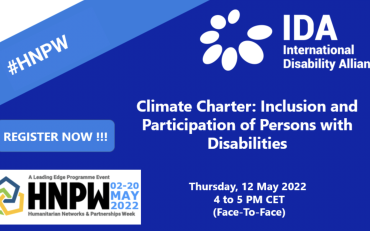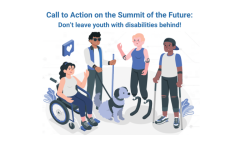During the Humanitarian Networks and Partnerships Weeks (HNPW) in Geneva, the disability inclusiveness of the Climate and Environmental Charter was discussed.
The Charter
The Charter was developed by the International Committee of the Red Cross (ICRC) and the International Federation of Red Cross and Red Crescent Societies (IFRC), with support of an advisory committee bringing together climate, environment, and humanitarian experts and in consultation with the humanitarian sector. It is designed for all humanitarian organisations and aims to stimulate strong collective commitment to climate action.[1]
The Charter is a welcome acknowledgment of the urgency of climate change as a humanitarian crisis and of the key role of local, national and international humanitarian organisations in climate mitigation. It entails seven commitments that should be implemented through organization-specific targets and action plans. Unfortunately, people with disabilities are only mentioned as one of the groups of individuals more at risk. There is no particular mention of how the rights of persons with disabilities and their inclusion should be guaranteed in the implementation of the Charter.
The Event
The aim of the event was to discuss ways to ensure that the implementation of the Climate and Environmental Charter is inclusive of persons with disabilities and to discuss how persons with disabilities and their representative organizations can contribute to the implementation of the Charter. The panel was made up of Elham Youssefian, Inclusive Humanitarian Action and Disaster Risk Reduction (DRR) Advisor from the International Disability Alliance (IDA), Johanna Mang from Light for the World and Jennifer M’Vouama from Humanity & Inclusion. The discussion was moderated by Amir Khouzam, Policy Advisor with the Policy and Humanitarian Diplomacy Division with the ICRC, and opening remarks were given by Kimmo Laukkanen, Deputy Permanent Representative of the Permanent Mission of Finland in Geneva.
Laukkanen talked about how promoting the rights of persons with disabilities is a top priority for Finland and that climate change is at the very centre of its policy objectives. He pointed out that Finland endeavours to be carbon-neutral and to be the first fossil-free country by 2035.
He also said that Finland believes that climate action provides opportunities to be more inclusive, for example by making sure that climate information is provided in accessible formats and that the disaster management process includes persons with disabilities.
Youssefian talked about the various ways in which persons with disabilities are disproportionally impacted by climate change. She pointed out that 80% of persons with disabilities live in developing countries with a strong majority of them living in poverty and “the poorer you are, the more and earlier you experience the impact of climate change,” because poor people often end up living in areas which are under more risk of floods and because there is a lack of accessible infrastructure.
Persons with disabilities often face difficulties with evacuation as the programs are not always inclusive, early warning systems are not accessible and humanitarian workers are not properly informed about how to evacuate persons with disabilities. When a crisis or disaster takes place, persons with disabilities cannot use many of the adaptations or coping mechanisms as those without disabilities, said Youssefian.
If a person with disabilities manages to be evacuated from a disaster caused by climate change, they are again confronted with additional barriers to access humanitarian assistance. Often persons with disabilities rely on their family network and social services and they struggle to re-establish those networks when being displaced. For instance, a deaf person used to communicate only in the local sign language, will find it difficult to communicate after displacement. On the other hand, measures seeking to mitigate climate change often overlook their impact on persons with disabilities and might be detrimental to their rights. For example, the switch to paper straws makes it very difficult for some persons with disabilities to take in their food. If the ultimate goal of being greener is to help people build a better life, excluding some people in achieving it is against that goal, Youssefian said.
How can climate adaptation and resilience building be more inclusive of persons with disabilities?
Mang pointed out that one of the possible reasons why humanitarian action is not inclusive of persons with disabilities is because they have never been part of the solution.
“We need to shift from seeing persons with disabilities as victims to considering everyone as an actor in climate change,” said Mang. We have to pay attention to the local level when the crisis hits. We must adjust humanitarian assistance based on the local assessment. Moreover, preparedness education should be accessible to everyone so that local plans and measures are inclusive.
M’Vouama acknowledged that there are several pathways towards disability inclusiveness. She said it is important to train the staff of humanitarian organizations, to raise awareness on its disproportionate impact on persons with disabilities and to collect disaggregated data to trigger meaningful responses and to embed inclusion throughout the entire project cycle. Furthermore, she held that persons with disabilities and their representative organisations need to be empowered and engaged as stakeholders in policy making at several levels. Traditional knowledge and coping mechanisms in the community also need to be mobilized.
In this regard, Youssefian pointed out that persons with disabilities have additional experience coping and finding solutions throughout their life and that these capacities can also be translated into their role in climate action.
Can climate change and climate action become an entry point to discuss the barriers persons with disabilities face throughout their lives in general and on all levels, apart from climate mitigation?
Mang is convinced that inclusiveness refers to universal design which means it should benefit everyone, pointing to the importance of intersectionality. Youssefian made the remark that we need the twin track approach in every area. That means that we need both specific action as well as mainstreaming. Because of the historic marginalization faced by persons with disabilities, mainstream action is not enough.
Youssefian also said that if climate mitigation programs are designed and based on rights of persons with disabilities, they cannot only be more successful in itself, but they can also be successful in enhancing accessibility in general.
The event also had an important positive tone. Youssefian acknowledged that the topic of climate action and inclusiveness of persons with disabilities has been really picked up in the last couple of years by multiple organisations and governments. She shared that it is one of the top priorities for IDA in the future as well. Mang remarked that climate action is now paid attention to by almost everyone and that we have to use this momentum. M’Vouama pointed to the fact that climate change is such a global issue affecting everyone, everywhere which makes the response to it an opportunity to build more resilient inclusive societies for all, including persons with disabilities.
Amir Khouzam concluded the discussion by stating that we need both broad and specific action and we need to start with inclusion from the beginning of the design of programs and policies.
We need to collect disaggregated data but the lack thereof cannot be an excuse for not taking action. Persons with disabilities need to be considered as actors in climate change mitigation instead of only as its victims. Persons with disabilities have an important role to play in climate action because in living with disabilities they learned to be resilient and find solutions. They should be included to bring their perspectives and to make sure nobody is left behind.

